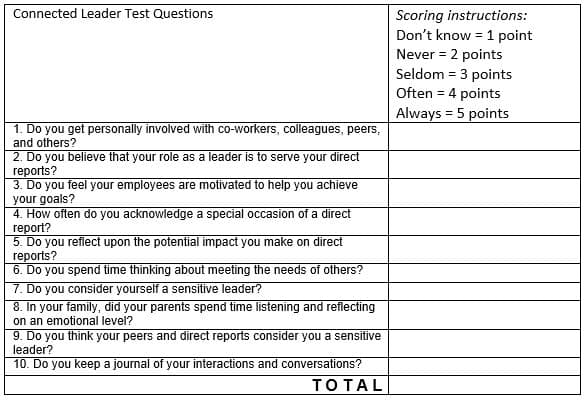Is Your Level of Connectedness with Employees Helping or Hurting Performance?

Research has shown that leaders who are able to connect with their employees are more successful. This is because connection creates a depth of relationship that translates into improved productivity, less turnover, and a more engaged work force.
 For a manager to be connected to employees requires, in part, understanding the personality traits of the employees. The type of personality tests that we conduct and assess for our clients can provide the insight for this level of understanding. Knowing the employee is only half the equation, of course. The manager must “know thyself”.
For a manager to be connected to employees requires, in part, understanding the personality traits of the employees. The type of personality tests that we conduct and assess for our clients can provide the insight for this level of understanding. Knowing the employee is only half the equation, of course. The manager must “know thyself”.
There’s the “my way or the highway” type of boss. You know the kind, always forcing workers to do things in a way that isn’t natural for them. Wouldn’t it be better to use your understanding of personality traits to tap into the natural flow so you can get the best out of your people? Of course, knowing your employees, understanding their concerns, and developing connected relationships with them should be the normal procedure for all managers.
The Value of Connected Relationships
What is the payoff to a manager for developing connected relationships with employees using personality assessments? Here are three good benefits.
- IT enables the manager to better anticipate what roadblocks might occur with a worker, and what to try to reduce this resistance.
- Understanding where employees are coming from will help you plan out how much participation you need from them and will give some clues as to how change should be communicated to them.
- Creating connected relationships builds commitment and loyalty.
Take the Connected Leader Test
How connected are you as a manager? To find out, we asked our colleague Dr. Bruce Heller, an industrial psychologist with twenty years’ experience and author of The Prodigal Executive–How to Coach Executives Too Painful to Keep, Too Valuable to Fire, to help us design a quick connected leader self-test. For each of the ten questions, choose the response that best matches your situation. Then give yourself the corresponding point value for each question. Total up your score and look to the end of the test for how to interpret your score.
This self-test helps you identify what level of connected leader you are.
Here are the breakdowns for your scoring. If you scored:
0–14
You are disconnected from the people who make up your organization.
To become more connected, you may need to hire an executive coach.
15–26
Your connections are frail and therefore you could benefit from taking more time to think about others and find ways to connect with them. Sharing something about yourself will be effective. Also, begin to keep a journal of your interactions. Think about ways you can become more connected to people in your organization.
27–36
You are a connected leader. This means that you connect with your team and work towards building relationships. However, you could benefit from being even more connected by spending time walking around and speaking to people and especially beginning to share with people something about you personally. This can mean a hobby or an interest.
36–50
You are deeply connected as a leader. You have an ability to think about ways to communicate and be sensitive to the needs of the people in your organization. Therefore, people want to work for you and you have a loyal following.
If you’re intrigued by the value of “connectedness” and the role personality test assessments can play in hiring and the day-to-day management of direct reports, more insight is available in my blog, This is Only a Test, Connected Managing by Personality Traits.
Category : Talent Management
Tags: Leadership

